2007 CHEVROLET EQUINOX Bumper
[x] Cancel search: BumperPage 89 of 492
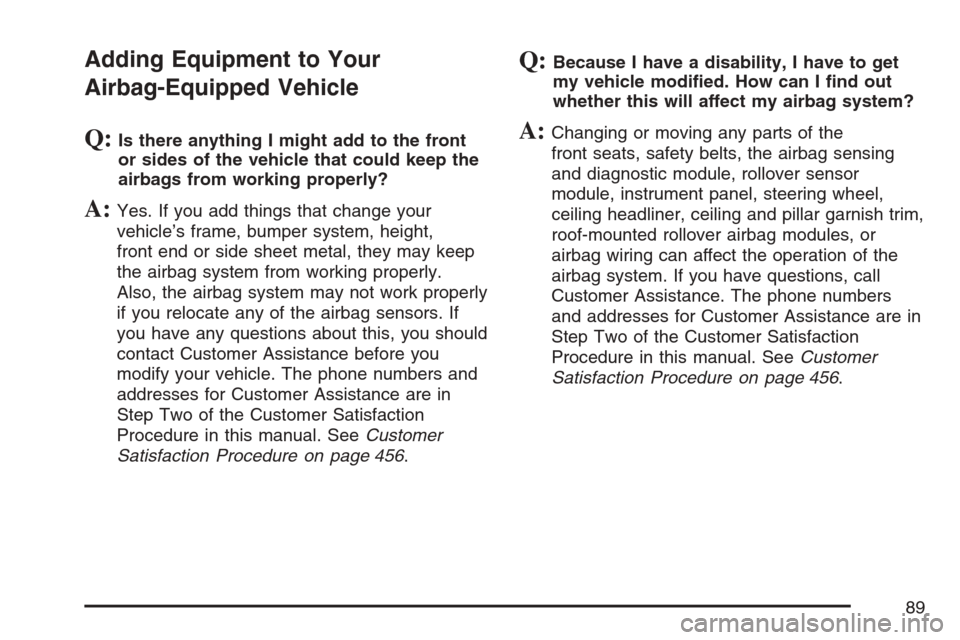
Adding Equipment to Your
Airbag-Equipped Vehicle
Q:Is there anything I might add to the front
or sides of the vehicle that could keep the
airbags from working properly?
A:Yes. If you add things that change your
vehicle’s frame, bumper system, height,
front end or side sheet metal, they may keep
the airbag system from working properly.
Also, the airbag system may not work properly
if you relocate any of the airbag sensors. If
you have any questions about this, you should
contact Customer Assistance before you
modify your vehicle. The phone numbers and
addresses for Customer Assistance are in
Step Two of the Customer Satisfaction
Procedure in this manual. SeeCustomer
Satisfaction Procedure on page 456.
Q:Because I have a disability, I have to get
my vehicle modi�ed. How can I �nd out
whether this will affect my airbag system?
A:Changing or moving any parts of the
front seats, safety belts, the airbag sensing
and diagnostic module, rollover sensor
module, instrument panel, steering wheel,
ceiling headliner, ceiling and pillar garnish trim,
roof-mounted rollover airbag modules, or
airbag wiring can affect the operation of the
airbag system. If you have questions, call
Customer Assistance. The phone numbers
and addresses for Customer Assistance are in
Step Two of the Customer Satisfaction
Procedure in this manual. SeeCustomer
Satisfaction Procedure on page 456.
89
Page 326 of 492
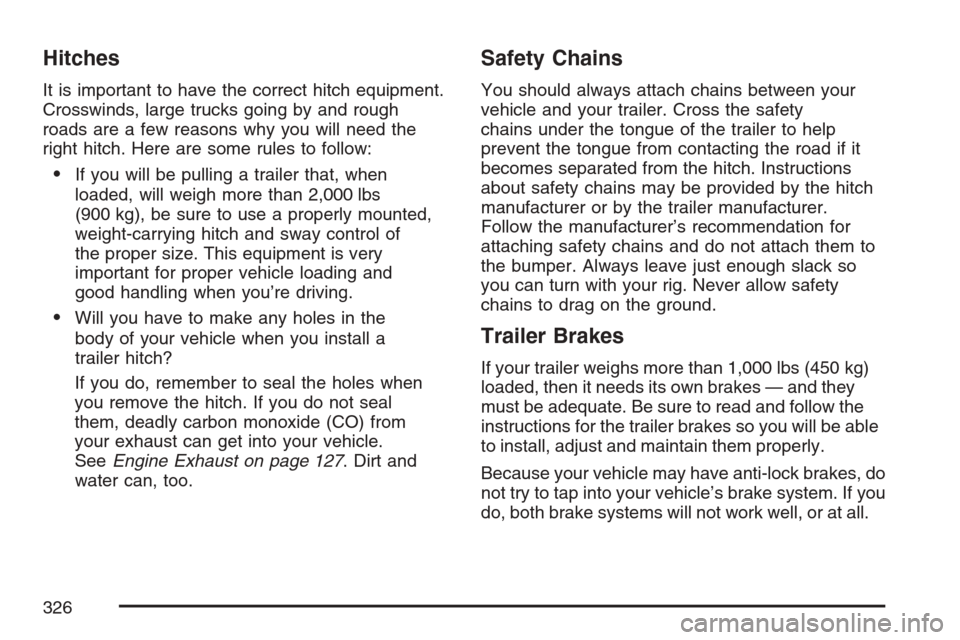
Hitches
It is important to have the correct hitch equipment.
Crosswinds, large trucks going by and rough
roads are a few reasons why you will need the
right hitch. Here are some rules to follow:
If you will be pulling a trailer that, when
loaded, will weigh more than 2,000 lbs
(900 kg), be sure to use a properly mounted,
weight-carrying hitch and sway control of
the proper size. This equipment is very
important for proper vehicle loading and
good handling when you’re driving.
Will you have to make any holes in the
body of your vehicle when you install a
trailer hitch?
If you do, remember to seal the holes when
you remove the hitch. If you do not seal
them, deadly carbon monoxide (CO) from
your exhaust can get into your vehicle.
SeeEngine Exhaust on page 127. Dirt and
water can, too.
Safety Chains
You should always attach chains between your
vehicle and your trailer. Cross the safety
chains under the tongue of the trailer to help
prevent the tongue from contacting the road if it
becomes separated from the hitch. Instructions
about safety chains may be provided by the hitch
manufacturer or by the trailer manufacturer.
Follow the manufacturer’s recommendation for
attaching safety chains and do not attach them to
the bumper. Always leave just enough slack so
you can turn with your rig. Never allow safety
chains to drag on the ground.
Trailer Brakes
If your trailer weighs more than 1,000 lbs (450 kg)
loaded, then it needs its own brakes — and they
must be adequate. Be sure to read and follow the
instructions for the trailer brakes so you will be able
to install, adjust and maintain them properly.
Because your vehicle may have anti-lock brakes, do
not try to tap into your vehicle’s brake system. If you
do, both brake systems will not work well, or at all.
326
Page 403 of 492

Notice:The wrong wheel can also cause
problems with bearing life, brake cooling,
speedometer or odometer calibration,
headlamp aim, bumper height, vehicle ground
clearance, and tire or tire chain clearance
to the body and chassis.
SeeChanging a Flat Tire on page 404for more
information.
Used Replacement Wheels
{CAUTION:
Putting a used wheel on your vehicle is
dangerous. You cannot know how it has
been used or how far it has been driven.
It could fail suddenly and cause a crash.
If you have to replace a wheel, use a new
GM original equipment wheel.
Tire Chains
{CAUTION:
Do not use tire chains. There is not enough
clearance. Tire chains used on a vehicle
without the proper amount of clearance
can cause damage to the brakes,
suspension or other vehicle parts. The area
damaged by the tire chains could cause
you to lose control of your vehicle and you
or others may be injured in a crash.
Use another type of traction device only
if its manufacturer recommends it for use
on your vehicle and tire size combination
and road conditions. Follow that
manufacturer’s instructions. To help avoid
damage to your vehicle, drive slowly,
readjust or remove the device if it is
contacting your vehicle, and do not spin
your vehicle’s wheels. If you do �nd
traction devices that will �t, install them
on the front tires.
403
Page 462 of 492
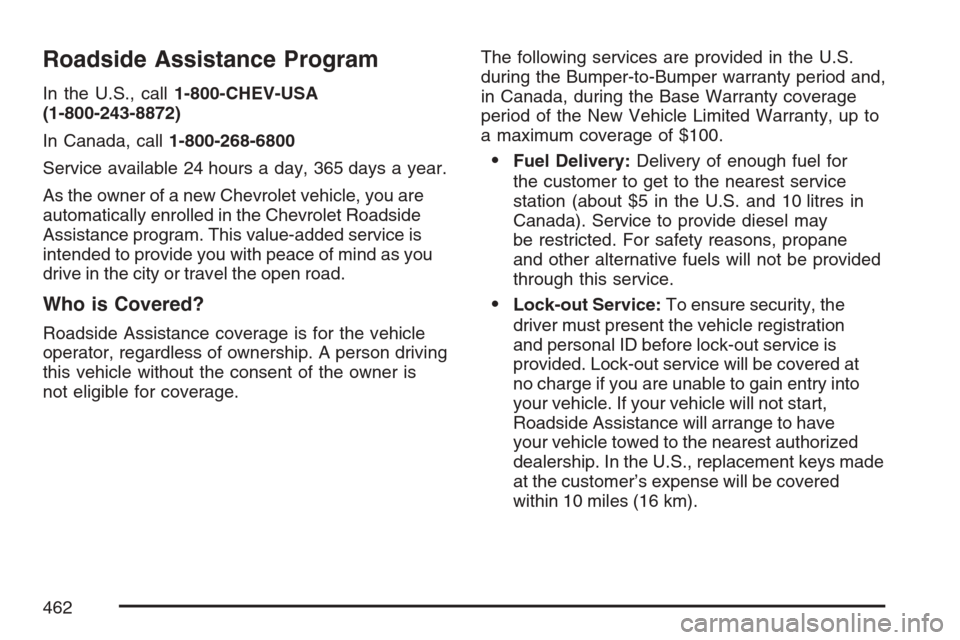
Roadside Assistance Program
In the U.S., call1-800-CHEV-USA
(1-800-243-8872)
In Canada, call1-800-268-6800
Service available 24 hours a day, 365 days a year.
As the owner of a new Chevrolet vehicle, you are
automatically enrolled in the Chevrolet Roadside
Assistance program. This value-added service is
intended to provide you with peace of mind as you
drive in the city or travel the open road.
Who is Covered?
Roadside Assistance coverage is for the vehicle
operator, regardless of ownership. A person driving
this vehicle without the consent of the owner is
not eligible for coverage.The following services are provided in the U.S.
during the Bumper-to-Bumper warranty period and,
in Canada, during the Base Warranty coverage
period of the New Vehicle Limited Warranty, up to
a maximum coverage of $100.
Fuel Delivery:Delivery of enough fuel for
the customer to get to the nearest service
station (about $5 in the U.S. and 10 litres in
Canada). Service to provide diesel may
be restricted. For safety reasons, propane
and other alternative fuels will not be provided
through this service.
Lock-out Service:To ensure security, the
driver must present the vehicle registration
and personal ID before lock-out service is
provided. Lock-out service will be covered at
no charge if you are unable to gain entry into
your vehicle. If your vehicle will not start,
Roadside Assistance will arrange to have
your vehicle towed to the nearest authorized
dealership. In the U.S., replacement keys made
at the customer’s expense will be covered
within 10 miles (16 km).
462
Page 464 of 492
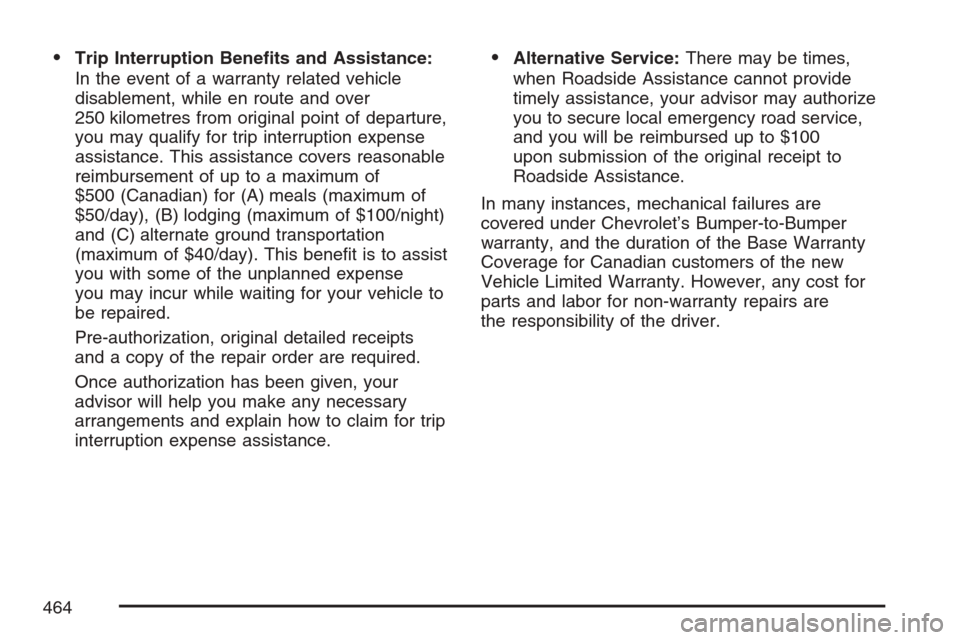
Trip Interruption Bene�ts and Assistance:
In the event of a warranty related vehicle
disablement, while en route and over
250 kilometres from original point of departure,
you may qualify for trip interruption expense
assistance. This assistance covers reasonable
reimbursement of up to a maximum of
$500 (Canadian) for (A) meals (maximum of
$50/day), (B) lodging (maximum of $100/night)
and (C) alternate ground transportation
(maximum of $40/day). This bene�t is to assist
you with some of the unplanned expense
you may incur while waiting for your vehicle to
be repaired.
Pre-authorization, original detailed receipts
and a copy of the repair order are required.
Once authorization has been given, your
advisor will help you make any necessary
arrangements and explain how to claim for trip
interruption expense assistance.Alternative Service:There may be times,
when Roadside Assistance cannot provide
timely assistance, your advisor may authorize
you to secure local emergency road service,
and you will be reimbursed up to $100
upon submission of the original receipt to
Roadside Assistance.
In many instances, mechanical failures are
covered under Chevrolet’s Bumper-to-Bumper
warranty, and the duration of the Base Warranty
Coverage for Canadian customers of the new
Vehicle Limited Warranty. However, any cost for
parts and labor for non-warranty repairs are
the responsibility of the driver.
464
Page 466 of 492
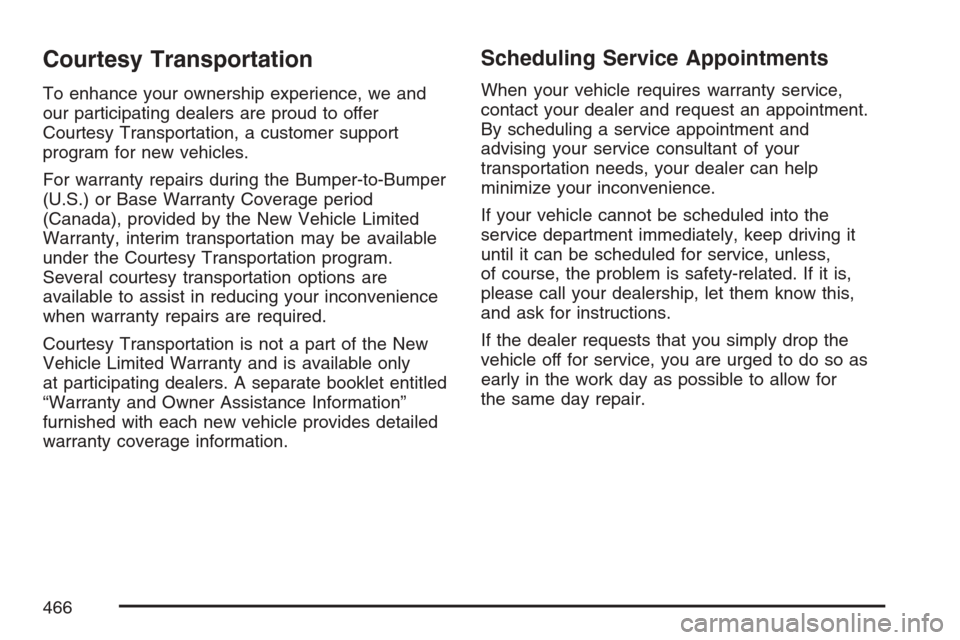
Courtesy Transportation
To enhance your ownership experience, we and
our participating dealers are proud to offer
Courtesy Transportation, a customer support
program for new vehicles.
For warranty repairs during the Bumper-to-Bumper
(U.S.) or Base Warranty Coverage period
(Canada), provided by the New Vehicle Limited
Warranty, interim transportation may be available
under the Courtesy Transportation program.
Several courtesy transportation options are
available to assist in reducing your inconvenience
when warranty repairs are required.
Courtesy Transportation is not a part of the New
Vehicle Limited Warranty and is available only
at participating dealers. A separate booklet entitled
“Warranty and Owner Assistance Information”
furnished with each new vehicle provides detailed
warranty coverage information.
Scheduling Service Appointments
When your vehicle requires warranty service,
contact your dealer and request an appointment.
By scheduling a service appointment and
advising your service consultant of your
transportation needs, your dealer can help
minimize your inconvenience.
If your vehicle cannot be scheduled into the
service department immediately, keep driving it
until it can be scheduled for service, unless,
of course, the problem is safety-related. If it is,
please call your dealership, let them know this,
and ask for instructions.
If the dealer requests that you simply drop the
vehicle off for service, you are urged to do so as
early in the work day as possible to allow for
the same day repair.
466